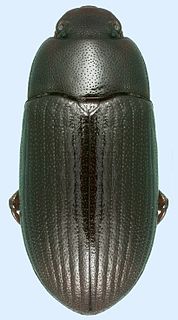 W
WAlphitobius diaperinus is a species of beetle in the family Tenebrionidae, the darkling beetles. It is known commonly as the lesser mealworm and the litter beetle. It has a cosmopolitan distribution, occurring nearly worldwide. It is known widely as a pest insect of stored food grain products such as flour, and of poultry-rearing facilities. It is a vector of many kinds of animal pathogens.
 W
WMezium americanum, the American spider beetle or black spider beetle, is a species of beetle in the subfamily Ptininae, the spider beetles. These are sometimes mistaken for spiders or mites because of their rounded abdomens and long legs. It has a cosmopolitan distribution, but it is an exotic species in Australia.
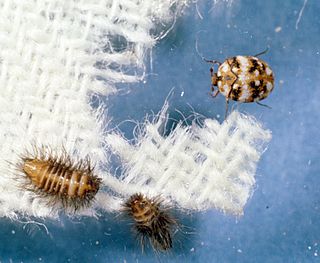 W
WAnthrenus flavipes is a species of beetle in the family Dermestidae known by the common name furniture carpet beetle. It has a cosmopolitan distribution, occurring throughout the world, being most active in warmer climates. It is a pest that damages household materials such as textiles.
 W
WAphis craccivora, variously known as the cowpea aphid, groundnut aphid or black legume aphid, is a true bug in the family Aphididae. Originally of probable Palearctic origin, it is now an invasive species of cosmopolitan distribution.
 W
WAprostocetus is a genus of hymenopteran insects of the family Eulophidae. The genus was erected by John O. Westwood in 1833. This very large group has a global distribution.
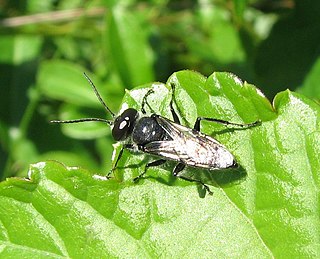 W
WAstata is a cosmopolitan genus of solitary predatory wasps in the subfamily Astatinae. They are known to prey on adults and nymphs of Pentatomidae. Astata is the largest genus in this subfamily, and is identified by features of its wing venation. The males of this genus and the related genus Dryudella have very large compound eyes that broadly meet at the top of the head.
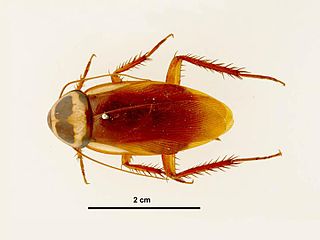 W
WThe Australian cockroach is a common species of tropical cockroach, with a length of 23–35 mm (0.91–1.38 in). It is brown overall, with the tegmina having a conspicuous lateral pale stripe or margin, and the pronotum with a sharply contrasting pale or yellow margin. It is very similar in appearance to the American cockroach and may be easily mistaken for it. It is, however, slightly smaller than the American cockroach, and has a yellow margin on the thorax and yellow streaks at its sides near the wing base.
 W
WCallosobruchus maculatus is a species of beetles known commonly as the cowpea weevil or cowpea seed beetle. It is a member of the leaf beetle family, Chrysomelidae, and not a true weevil. This common pest of stored legumes has a cosmopolitan distribution, occurring on every continent except Antarctica. The beetle most likely originated in West Africa and moved around the globe with the trade of legumes and other crops. As only a small number of individuals were likely present in legumes carried by people to distant places, the populations that have invaded various parts of the globe have likely gone through multiple bottlenecks. Despite these bottlenecks and the subsequent rounds of inbreeding, these populations persist. This ability to withstand a high degree of inbreeding has likely contributed to this species’ prevalence as a pest.
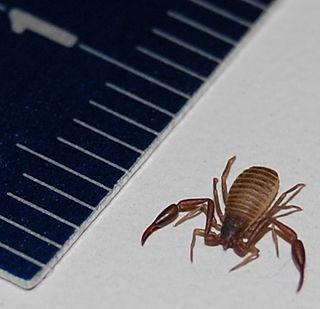 W
WChelifer cancroides, the house pseudoscorpion, is a species of pseudoscorpions. It is a cosmopolitan, synanthropic, and harmless species to humans.
 W
WChelisoches morio, commonly known as the black earwig, is a cosmopolitan earwig in the family Chelisochidae. Black earwigs are active at all times of the day, and prefer wet habitats. Adults can grow up to 36 millimetres (1.4 in).
 W
WCoccus hesperidum is a soft scale insect in the family Coccidae with a wide host range. It is commonly known as brown soft scale. It has a cosmopolitan distribution and feeds on many different host plants. It is an agricultural pest, particularly of citrus and commercial greenhouse crops.
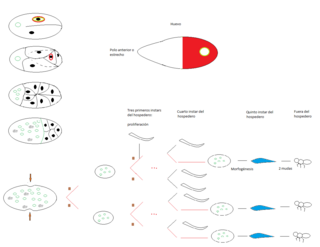 W
WCopidosoma floridanum is a species of wasp in the family Encyrtidae which is primarily a parasitoid of moths in the subfamily Plusiinae. It has the largest recorded brood of any parasitoidal insect, at 3,055 individuals. The life cycle begins when a female oviposits into the eggs of a suitable host species, laying one or two eggs per host. Each egg divides repeatedly and develops into a brood of multiple individuals, a phenomenon called polyembryony. The larvae grow inside their host, breaking free at the end of the host's own larval stage.
 W
WDaphnia pulex is the most common species of water flea. It has a cosmopolitan distribution: the species is found throughout the Americas, Europe and Australia. It is a model species, and was the first crustacean to have its genome sequenced.
 W
WEristalis tenax, the common drone fly, is a common, migratory, cosmopolitan species of hover fly. It is the most widely distributed syrphid species in the world and is known from all regions except the Antarctic. It has been introduced into North America and is widely established. It can be found in gardens and fields in Europe and Australia. It has also been found in the Himalayas.
 W
WFannia scalaris, also known as the latrine fly, is a fly species in the Fanniidae family. This species is smaller and more slender than the house fly, Musca domestica, and is similar in appearance to the lesser house fly, Fannia canicularis. The life cycle of this species can be as long as one month. These flies are globally distributed in urban areas as they are drawn to unsanitary environments. F. scalaris is a major cause of myiasis, the infestation of a body cavity by fly maggots. The adults infest bodies that have decomposed, making the species an important part of forensic entomology. The larvae of this fly have adapted protuberances, or feathered appendages, that allow them to survive in such a moist environment. Entomologists continue to research the effects that F. scalaris may have medically, forensically, and on the environment around them.
 W
WHouse dust mites are mites found in association with dust in dwellings. They are known for causing an allergy.
 W
WThe housefly is a fly of the suborder Cyclorrhapha. It is believed to have evolved in the Cenozoic Era, possibly in the Middle East, and has spread all over the world as a commensal of humans. It is the most common fly species found in houses. Adults are gray to black, with four dark, longitudinal lines on the thorax, slightly hairy bodies, and a single pair of membranous wings. They have red eyes, set farther apart in the slightly larger female.
 W
WLabidura riparia is a species of earwig in the family Labiduridae characterized by their modified cerci as forceps, and light tan color. They are commonly known as the shore earwig, tawny earwig, riparian earwig, or the striped earwig due to two dark longitudinal stripes down the length of the pronotum. They are sometimes wrongly referred to as Labidura japonica, although said species is actually a subspecies, Labidura riparia japonica, found only in Japan. L. riparia are a cosmopolitan species primarily in tropical to subtropical regions. Body size varies greatly, ranging from 16 mm to 30 mm, with 10 abdominal segments. Males and females differ in forcep size, with males having much larger and stronger curve, while females have smaller, straighter forceps with a slight curve at the end. Earwigs use these forceps to assist in predation, defense, sexual selection, courting and mating, and wing folding.
 W
WLepas anatifera, commonly known as the pelagic gooseneck barnacle or smooth gooseneck barnacle, is a species of barnacle in the family Lepadidae. These barnacles are found, often in large numbers, attached by their flexible stalks to floating timber, the hulls of ships, piers, pilings, seaweed and various sorts of flotsam.
 W
WLepidurus apus, commonly known as a tadpole shrimp, is a notostracan in the family Triopsidae, one of a lineage of shrimp-like crustaceans that have had a similar form since the Triassic period and are considered living fossils. This species is cosmopolitan, inhabiting temporary freshwater ponds over much of the world, and the most widespread of the tadpole shrimps. Like other notostracans, L. apus has a broad carapace, long segmented abdomen, and large numbers of paddle-like legs. It reproduces by a mixture of sexual reproduction and self-fertilisation of females.
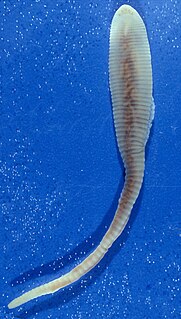 W
WLinguatula serrata is a cosmopolitan zoonotic parasite, belonging to the tongueworm order Pentastomida. They are wormlike parasites of the respiratory systems of vertebrates. They live in the nasopharyngeal region of mammals. Cats, dogs, foxes, and other carnivores are normal hosts of this parasite. Apparently, almost any mammal is a potential intermediate host.
 W
WAnisolabis maritima, commonly known as the maritime earwig or the seaside earwig, is a species of earwig in the family Anisolabididae. Similar to the seashore earwig, this species can be found near the shore line, and is cosmopolitan. It can be found in almost all biogeographic realms. Scientists believe that these earwigs originally came from Asia. Since then, however, they have been introduced to North America, and have now spread around the world due to international commerce.
 W
WNecrobia ruficollis, the ham beetle, red-shouldered ham beetle, or red-necked bacon beetle, is a mostly carnivorous beetle in the family Cleridae with a cosmopolitan distribution.
 W
WNecrobia rufipes, the red-legged ham beetle, is a species of predatory beetle, in the family Cleridae, with a cosmopolitan distribution, first described by Charles De Geer in 1775.
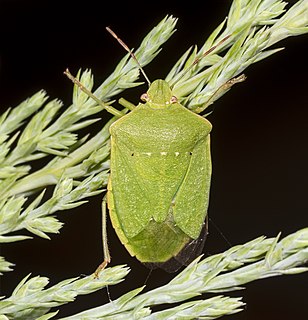 W
WNezara viridula, commonly known as the southern green stink bug (USA), southern green shield bug (UK) or green vegetable bug, is a plant-feeding stink bug. Believed to have originated in Ethiopia, it can now be found around the world. Because of its preference for certain species of legumes, such as beans and soybeans, it is an economically important pest on such crops.
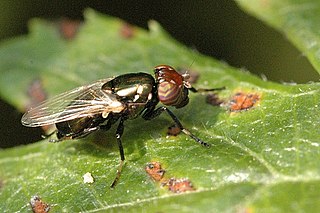 W
WPhysiphora alceae is a species of ulidiid or picture-winged fly in the genus Physiphora of the family Ulidiidae.
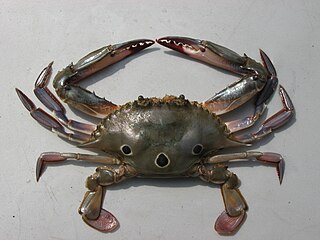 W
WThe three-spot swimming crab, also known as the blood-spotted swimming crab or red-spotted swimming crab, is a large crab found throughout estuaries of the Indian and West Pacific Oceanic countries.
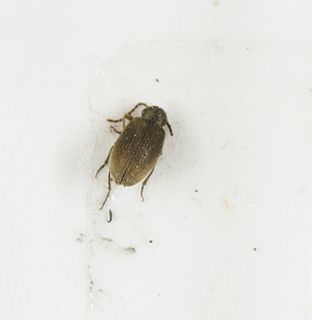 W
WPtinus tectus, often called the Australian spider beetle, is a species of beetle in the genus Ptinus of the family Ptinidae, or family Anobiidae, subfamily Ptininae. It is a cosmopolitan species. It is a pest of stored foods and museum specimens.
 W
WThe Cattle tick,, is a hard-bodied tick of the genus Rhipicephalus. It is also known as North American cattle tick, North American Texas fever tick, and Texas fever tick.
 W
WRhipicephalus sanguineus, commonly called the brown dog tick, kennel tick, or pantropical dog tick, is a species of tick found worldwide, but more commonly in warmer climates. This species is unusual among ticks in that its entire lifecycle can be completed indoors. The brown dog tick is easily recognized by its reddish-brown color, elongated body shape, and hexagonal basis capituli. Adults are 2.28 to 3.18 mm in length and 1.11 to 1.68 mm in width. They do not have ornamentation on their backs.
 W
WRodolia is a genus of ladybird beetles belonging to the family Coccinellidae.
 W
WSarcoptes scabiei or the itch mite is a parasitic mite that burrows into skin and causes scabies. The mite is found in all parts of the world. Humans are not the only mammals that can become infected. Other mammals, such as wild and domesticated dogs and cats as well as ungulates, wild boars, bovids, wombats, koalas, and great apes are affected.
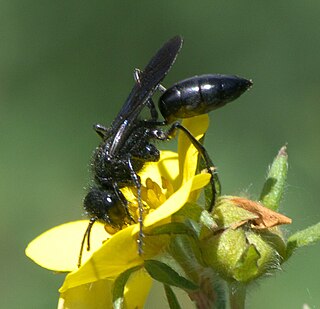 W
WThe Sphecidae are a cosmopolitan family of wasps of the suborder Apocrita that includes sand wasps, mud daubers, and other thread-waisted wasps.
 W
WThe Surinam cockroach or greenhouse cockroach is a species of burrowing cockroach. It is a common plant pest endemic to the Indomalayan realm that has spread to tropical and into subtropical regions around the world, and in isolated populations to temperate climates where protective habitat such as greenhouses provide shelter for individuals inadvertently shipped in the soil of plants. Its populations are almost exclusively female, and it reproduces through parthenogenesis, having evolved several clonal strains from its sexual progenitor P. indicus.
 W
WTenebroides mauritanicus, commonly known as the cadelle, is a cosmopolitan and common pest in storehouses and granaries. Adults and larvae feed on grain and grain products, predate upon other insects infesting grain, and bore into wood. They typically pupate in wood cavities that they make. It is one of the longest lived insects that attacks stored grain and is very destructive and easily dispersed. It is also one of the largest.
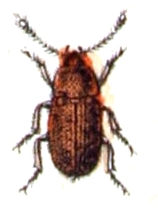 W
WTyphaea stercorea is a cosmopolitan species of beetle of the family Mycetophagidae, known by the common name hairy fungus beetle.
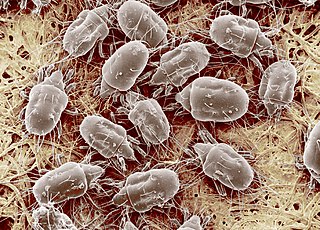 W
WTyrophagus putrescentiae is a cosmopolitan mite species. Together with the related species T. longior, it is commonly referred to as the mould mite or the cheese mite. The name translates from Greek to something like "putrid cheese eater."
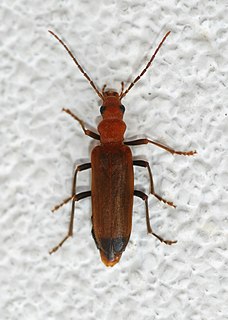 W
WThe wharf borer, Nacerdes melanura, belongs to the insect order Coleoptera, the beetles. They belong to the family Oedemeridae, which are commonly known as false blister beetles. Wharf borers are present in all the states of the USA except for Florida. It takes about a year to develop from an egg to an adult. The insect is called the 'wharf borer' because the larval stage of this insect is often found on pilings and timbers of wharves, especially along coastal areas. The adult beetles can be identified via a black band across the end of both elytra, or wing covers. In addition, wharf borers can be distinguished from other members of the family Oedemeridae via the presence of a single spur on the tibia of the forelegs, and the distance between both eyes. Eggs are oviposited on rotten wood where larvae hatch and burrow to feed on rotten wood. Adults do not feed and depend on stored energy reserves accumulated during the larval stage. They are considered to be a pest because they damage wood used in building infrastructures.